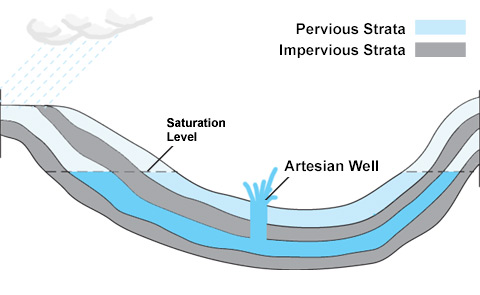Artesian Wells

When you take the top off of a soda bottle, you hear the rapid escape of gas, or a fizzing sound. The gas has been held in the bottle under pressure. When you take off the cap, you release that pressure and it quickly bursts out of the bottle. Likewise, water in a confined aquifer is under pressure. If you release that pressure, the confined groundwater will come flowing freely upward.
An artesian well is a well that is dug through a confining bed to reach a special kind of confined aquifer called an artesian aquifer. Because the well breaks through the confining bed, it is like taking the cap off of a soda bottle—the water is relieved of some of its pressure and bursts upward without a pump. The diagram shows how an artesian aquifer develops:
- There must be tilted rock strata to collect water infiltrating down from the surface.
- There must be permeable layers confined between impermeable layers (a confined aquifer).
- There must be sufficient precipitation to keep the aquifer recharged.
When these three conditions are met, and you drill a well into the confined aquifer, a free flowing (artesian) well results. These are important sources of drinking water in places where they exist.